lecture 6-2
- 格式:pdf
- 大小:179.81 KB
- 文档页数:71
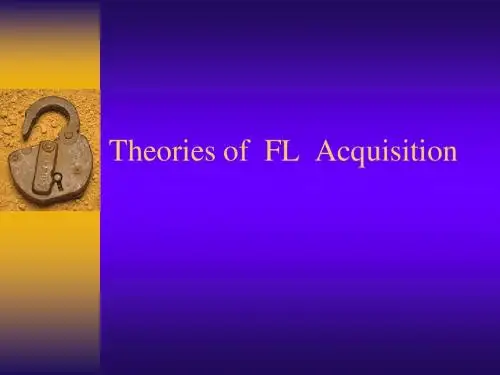

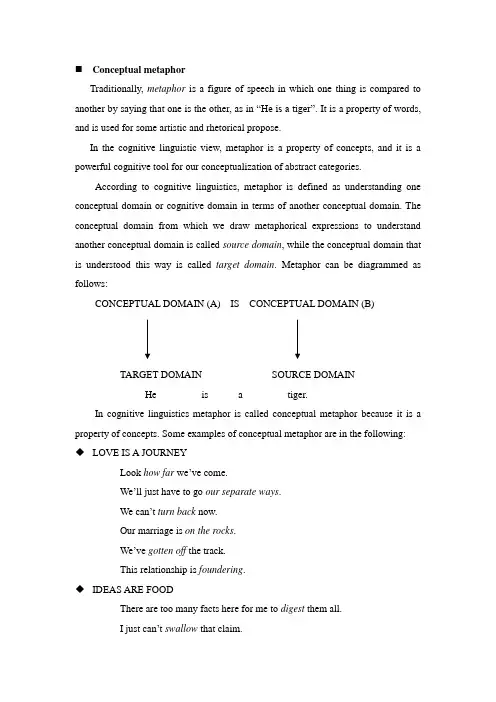
⏹Conceptual metaphorTraditionally, metaphor is a figure of speech in which one thing is compared to another by saying that one is the other, as in “He is a tiger”. It is a property of words, and is used for some artistic and rhetorical propose.In the cognitive linguistic view, metaphor is a property of concepts, and it is a powerful cognitive tool for our conceptualization of abstract categories.According to cognitive linguistics, metaphor is defined as understanding one conceptual domain or cognitive domain in terms of another conceptual domain. The conceptual domain from which we draw metaphorical expressions to understand another conceptual domain is called source domain, while the conceptual domain that is understood this way is called target domain. Metaphor can be diagrammed as follows:CONCEPTUAL DOMAIN (A) IS CONCEPTUAL DOMAIN (B)TARGET DOMAIN SOURCE DOMAINHe is a tiger.In cognitive linguistics metaphor is called conceptual metaphor because it is a property of concepts. Some examples of conceptual metaphor are in the following:◆LOVE IS A JOURNEYLook how far we’ve come.We’ll just have to go our separate ways.We can’t turn back now.Our marriage is on the rocks.We’ve gotten off the track.This relationship is foundering.◆IDEAS ARE FOODThere are too many facts here for me to digest them all.I just can’t swallow that claim.That’s food for thought.He devoured the book.◆AN ARGUMENT IS WARY our claims are indefensible.They attacked every weak point in our argument.I’ve never won an argument with him.Y ou disagree? Okay, shoot!If you use that strategy, he’ll wipe you out.He shot down all of my arguments.⏹Metonymy◆Definition: The word "metonymy" derives from a Greek word meaning"change of name". As a figure of speech, metonymy is very common ineveryday language. Like metaphor, it is a figurative use of language,involving the substitution of the name of one thing for that of another. Unlikemetaphor,the ground of the substitution in metonymy is not similarity, but association, i. e., the two unlike things do not have common quality but are closely associated. When we speak of one, the other will come up to our mindMetonymy involves the substitution of the name of one thing for that of another. For example,the name of a referent is substituted by the name of an attribute or entity related in some semantic way or by spatial proximity or by other reasons,✧Crown / sceptre-一king or queen✧bottle--alcoholic drinks✧sword--war and destruction✧the camp---the troops⏹Sources of Metonymy◆Body part◆Name of a person◆Name of a clear sign of an object or a person◆Name of a place◆Instrument or container◆Trade mark or brand◆Location✧The pen is mightier than the sword.✧Gray hairs should be respected.✧He is too fond of the bottles.✧I have never read James Joyce.✧She is far from the cradle.✧What is learned in the cradle is carried into the grave.✧His purse would not allow him that luxury.✧Y esterday I saw a pipe smoking John Bull astride a bicycle.✧We pay Uncle Sam with our taxes.✧That old goat thinks he is a real Romeo.★Differences between metaphor and metonymyMetaphor can be converted into simile,while metonymy can not;Metaphor appeals to the readers’imagination for similarity between the two different objects,while metonymy appeals to the reader's imagination for the association of ideas it provokes.✧All the world is a stage.✧She is a peacock.✧The kettle is boiling.✧He likes to read Hemingway.⏹Conceptual metonymyAccording to the classical definition, metonymy is a figure of speech in which one word is substituted for another on the basis of some material, causal, or conceptual relation. Some typical substitutions include author for work, place for a characteristic product of that place, object for possessor, abstract features for concrete entities, etc. Some examples are:(1)Have you ever read Shakespeare?(2)Wary wants Burgundy (red or white wine from the Burgundy area of France).(3)The crown objects to the proposal.(4)I want my love to be with me all the time.In the cognitive view of figurative language, the role of metaphor is paid attention to but not that of metonymy, in the construction of abstract categories. However, metonymy does play a very important part in the structures of emotion categories. For example, we have a general metonymic principle: THE BODILY SYMPTOMS OF AN EMOTION STAND FOR THE EMOTION. For example: drop in temperature for FEAR, erect posture for PRIDE, and jumping up and down for JOY. Obviously these physiological phenomena help us conceptualize these emotions.★The similarities between metonymy and metaphorboth are regarded as being conceptual in natureboth can be conventionalizedboth are means of extending the resources of a languageboth can be explained as mapping processes★The difference between metonymy and metaphormetaphor involves a mapping across different conceptual or cognitive domains while metonymy is a mapping within one conceptual domain.Metonymy (from a cognitive view) is a cognitive process in which one cognitive category, the source, provides mental access to another cognitive category, the target, within the same cognitive domain, or idealized cognitive model (ICM). The understanding of metonymy can be represented as the following figure:Generally speaking, the most commonly used conceptual metonymies are as follows:◆THE PRODUCER FOR THE PRODUCT (THE AUTHOR FOR THE WORK)✧She loves Picasso.✧Does he have any Hemingway in his collection?✧I’m reading Mark Twain.◆THE PLACE FOR THE EVENT✧America doesn’t want another Pearl Harbor.✧Watergate changed American politics.◆THE PLACE FOR THE INSTITUTION✧Washington is negotiating with Beijing.✧Wall Street is in a panic.✧Hollywood is putting out terrible movies.◆THE CONTROLLER FOR THE CONTROLLED✧Nixon bombed Hanoi.✧Ozawa gave a terrible concert last night.◆AN OBJECT USED FOR THE USER✧The sax has the flu today.✧We need a better glove at the third base.⏹Synecdoche◆Definition: A figure by which a more comprehensive term is used for a lesscomprehensive or vice versa; as whole for part or part for whole,genus forspecies or species for genus,etc.A figure of speech by which a part is put for the whole,the whole for a part,the species for the genus,the genus for the species,or the name of the material for the thing made.◆V arious types of Synecdoche:The part for the whole:The whole for the part:The abstract for the concrete,or the concrete for the abstractThe species for the genus,or the genus for the speciesName of the material for the thing made:◆Distinction between Metonymy and SynecdocheWith synecdoche,the relationship between the two things involved is part-and-whole: that is,one thing is a part of the other. whereas,with metonymy, the two things involved are completely different.✧Her heart ruled her head.✧He paid the workers$5 per head.。
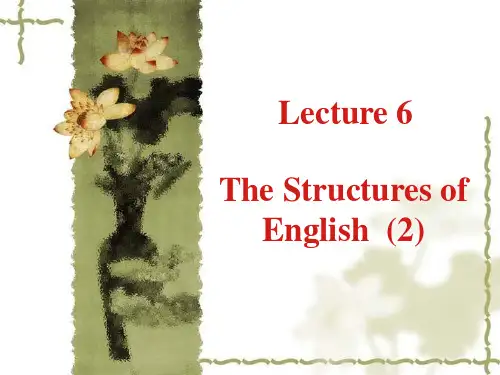
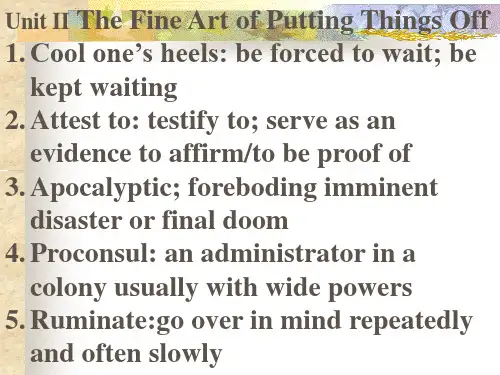

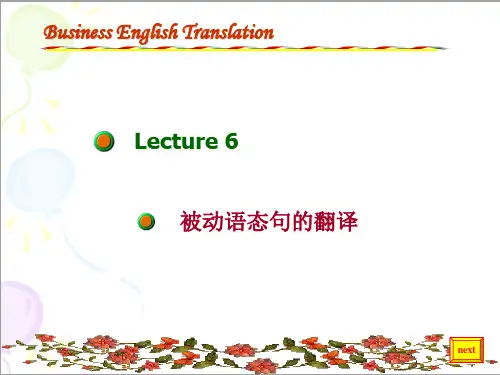

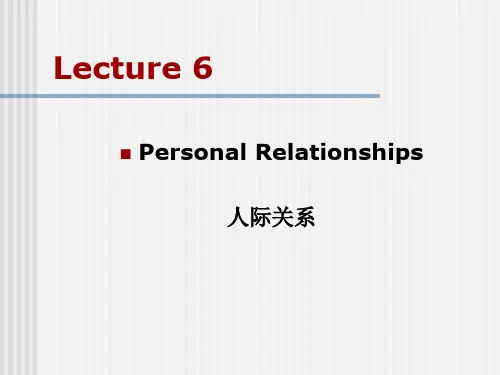
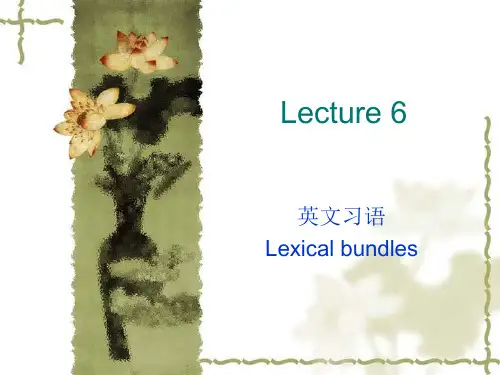

April 21, 2011 Lecture 7Nonverbal CommunicationCommunication is not simply a matter of speaking, writing and hearing. Meanings are conveyed not only by words or verbal language but also by nonverbal communication systems. These nonverbal communication devices accompany verbal communication to help to convey information, especially emotional information.It has been suggested that a considerable amount of information and most of the emotional information are conveyed by nonverbal communication systems.Definition of nonverbal communication Nonverbal communication can be defined in different ways. The basic definition should be like these:Nonverbal communication is the communication without the use of sounds and words.I. The Forms of nonverbal communicationTime[ Chronemics (时间学)]:The way of using time and its meaning Space [ Proxemics (空间学)]:The way of the use of space and its meaningKinesics/body language:Facial expressions, body movement, gestures,…Physical appearance:Study people‟s skin color, clothing…Oculesics(目光学):Study the information conveyed by eye contact, blinks, eye movements andpupil dilationParalanguage/V ocalics(副语言)-study the sound component ofnonlanguage.II. Kinesics / body languageLanguage studies traditionally have emphasized verbal and written language, but recently have begun to consider communication that takes place without words. In some types of communication people express more nonverbally thanverbally.e.g.If you ask an obviously depressed person, “what‟s wrong?”, and he answers, “Nothing, I‟m fine,”you probably won‟t believe him.When an angry person says, “Let‟s forget this subject, I don‟t want to talk about it any more!”you know that he hasn‟t stopped communicating. His silence and withdrawal continue to convey emotional meaning.One study done in the United States showed that in the communication of attitudes, 93 percent of the message was transmitted by the tone of voice and by facial expressions,whereas only 7 percent of the speaker’s attitude was transmitted by words.Apparently, we express ouremotions and attitudes more nonverbally than verbally.Nonverbal communication expresses meaning or feeling without words. Universal emotions, such as happiness, fear, and sadness, are expressed in a similar nonverbal way throughout the world.There are, however, nonverbal differences across cultures that may be a source of confusion for foreigners.e.g.feelings of friendship exist everywhere but their expression varies. It may be acceptable in some countries for men to embrace each other and for women to hold hands; in other countries these displays of affection may be shocking.What is acceptable in one culture may be completely unacceptable in another.One culture may determine that snapping fingers to call a waiter is appropriate; another may consider this gesture rude. We are often not aware of how gesture, facial expressions, eye contact, and the use of space affect communication. In order to correctly interpret another culture‟s style of communication, it is necessary to study the “silent language” of that culture.III. GesturesGestures refer to specific body movements that carry meanings. Hands can form shapes that convey many meanings: “stop,”“come here,”and “It‟s OK”and so on. Many ideas can be expressed nonverbally using only hands. The gestures for these phrases may differ among cultures. As children we imitate and learn these nonverbal movements and often use them to accompany or replacewords. When traveling to another country, foreign visitors soon learn that not all gestures are universal.e.g.The “OK”gesture in the American culture is a symbol for money in Japan. The same gesture is obscene or dirty in some Latin American countries. ( This is why the editors of a Latin American newspaper enjoyed publishing a picture of former president Nixon giving the OK symbol with both hands!)Introduction of some common gestures : (show some picures)…IV. Facial ExpressionsFacial expressions carry meanings determined by contexts and relationships.For instance, the smile, which istypically an expression of pleasure, has many functions. A woman‟s smile at a policeman who is about to give her a ticket does not carry the same meaning as the smile she gives to a young man. A smile may show affection, convey politeness, or disguise true feelings. Pain is conveyed by a grimace(痛苦状), which also signifies disgust or disapproval.Surprise, shock, or disbelief can be shown by raising the eyebrows. A wink given to a friend may mean “you and I have a secret”or “I‟m just kidding.”Between a man and a woman, a wink can be flirtatious(挑逗,调情). Our faces easily reveal emotions and attitudes.The degree of facial expressiveness also varies among individuals and cultures. The fact that members of one culture do not express their emotions as openly asmembers of another does not mean they do not experience emotions. Rather, there are cultural restrain on the amount of nonverbal expressiveness permitted.Because of individual differences, it is difficult to make generalizations about a cultural style of communication. Americans express themselves facially in varying degrees. People from certain ethnic backgrounds in the United States may use their hands, bodies, and faces more than other Americans.There are no fixed rules, although it is considered negative or suspicious to have a “deadpan” expression or a “poker face.”Some people can be “read like a book”; others are difficult to read.Eye ContactEye contact is important because insufficient or excessive eye contact may create communication barriers. It is important in relationships because it serves to show intimacy, attention, and influence. As with facial expressions, there are no specific rules governing eye behavior except that it is considered rude to stare, especially at strangers.It is, however, common for two strangers to walk toward each other, make eye contact, smile and perhaps even say “Hi.” The strangers may immediately look away and forget that they even had any contact. This type of glance does not mean much; it is simply a way of acknowledging another person‟s presence.In a conversation too little eye contact may be seen negatively because it conveys lack of interest, inattention, or even mistrust. The relationship between mistrustand lack of eye contact is stated directly in the expression, “Never trust a person who can‟t look you in the eyes.”V. SpaceUnconsciously, we all carry with us what have been called “body bubbles.”These bubbles are like invisible walls which define our personal space.The amount of space changes depending on the interpersonal relationship.e.g.we are usually more comfortable standing closer to family members than to strangers. Personality also determines the size of this space. Introverts(性格内向者)often prefer to interact with others at a greater distance than extroverts(性格外向者).Cultural styles are important too. A Japanese employer and employee usuallystand farther apart while talking than their American counterparts. Latin Americans and Arabs tend to stand closer together than Americans when talking.For Americans, distance in social conversation is about an arm‟s length to four feet. Less space in the American culture may be associated with greater intimacy or aggressive behavior.The common practice of saying “Excuse me,”or …Pardon me” for the slightest accidental touching of another person reveals an American attitude about personal space. Thus when a person‟s “space”is intruded upon by someone, he or she may feel threatened and react defensively. In cultures where close physical contact is acceptable and desirable, Americans may be perceived as cold and distant.Culture does not always determine the messages that our body movements convey. Contexts, personalities, and relationships also influence them.Therefore, no two people in any one society have the same nonverbal behavior.However, like verbal language, nonverbal communication cannot be completely separated from culture.Whether we emphasize differences or similarities, the “silent language” is much louder than it first appears.Questions:1.What is nonverbal communication?2.What is “body bubbles”?3.What does “poker face” mean?。